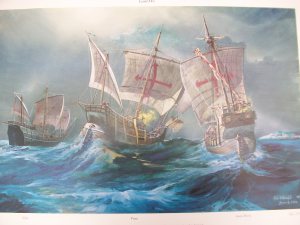 Trip from Puerto Rico to Florida
Trip from Puerto Rico to Florida
Juan Ponce de León was the first Spanish explorer to arrive in Florida. He became the first Governor of Puerto Rico by appointment of the Spanish crown. He led the first European expedition to Florida, which he named.
 450TH ANNIVERSARY OF THE FOUNDING OF ST. AUGUSTINE
450TH ANNIVERSARY OF THE FOUNDING OF ST. AUGUSTINE
Don Pedro Menéndez arrived in St. Augustine in 1565 with 800 colonists to settle the New World in the name of Spain. It was an ambitious attempt at colonization, one that would become the foundation for the most enduring settlement in the United States. Onboard were Africans and Hispanics. When they stepped off the ship into the first permanent colony in the United States, they became African-Americans and Hispanic-Americans. This was the beginning of both the African-American experience and the Latino-American experience in the New World. Native Americans were named so by Europeans and became this for the first time. The settlement at the Indian village of Seloy with the intermingling of Hispanics, Africans and Native Americans, was the very genesis of the American culture that characterizes our nation today.
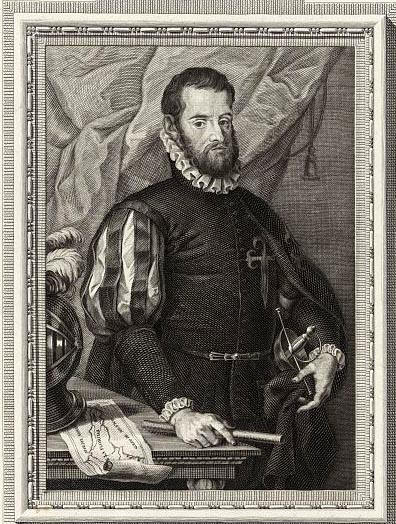 Pedro Menendez
Pedro Menendez
Pedro Menéndez de Avilés (15 February 1519 – 17 September 1574) was a Spanish admiral and explorer from the region of Asturias, Spain, who is remembered for planning the first regular trans-oceanic convoys and for founding St. Augustine, Florida, in 1565. This was the first successful Spanish settlement in La Florida and the most significant city in the region for nearly three centuries. St. Augustine is the oldest continuously-inhabited, European-established settlement in the continental United States. Source: https://en.wikipedia.org/wiki/Pedro_Men%C3%A9ndez_de_Avil%C3%A9s
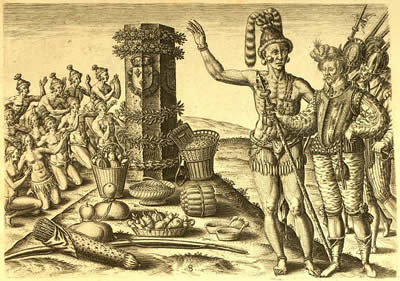 The pre-Columbian era was marked by regular, routine, and probably small tribal wars with neighbors. The Timucua were a large and powerful group, made up of as many as 35 chiefdoms, each of which had hundreds of people in assorted villages within its purview. They sometimes formed loose political alliances, but did not operate as a single political unit.
The pre-Columbian era was marked by regular, routine, and probably small tribal wars with neighbors. The Timucua were a large and powerful group, made up of as many as 35 chiefdoms, each of which had hundreds of people in assorted villages within its purview. They sometimes formed loose political alliances, but did not operate as a single political unit.
An archaeological dig in St. Augustine in 2006 revealed a Timucuan site dating back to between 1100 and 1300 AD, predating the European founding of the city by more than two centuries.Included in the discovery were pottery, with pieces from the Macon, Georgia, area, indicating an expansive trade network; and two human skeletons. It is the oldest archeological site in the city.[7]
The Timucua may have been the first American natives to see the landing of Juan Ponce de León near St. Augustine in 1513. Later, in 1528, Pánfilo de Narváez's expedition passed along the western fringes of the Timucua territory.[4].
From at least 6,000 years ago, the native people of Florida traveled the waterways and coasts by canoe, facilitating communication and trade among the tribes. About 300 prehistoric canoes have been found in more than 200 sites in Florida.
In the late 1400s and early 1500s, looking for a faster way to Asia by sea, European explorers sailed west and ran into the Americas. Seeing new resources to exploit, people to convert and lands to claim, the Spanish, the French and the English sent the military, missionaries and colonists to establish a foothold and expand their areas of control. The first evidence of a European encounter in Florida is the arrival of Spaniard Juan Ponce de Leon in the vicinity of present-day St. Augustine in 1513. Ponce de Leon named the land La Florida and attempted to circumnavigate what he thought was an island, sailing south to the Keys, naming a cluster of islands Las Tortugas and sailing north to present-day Tampa. Source: http://www.nps.gov/nr/travel/flshipwrecks/maritimehistory.htm
Ponce de León : Florida's First Spanish Explorer 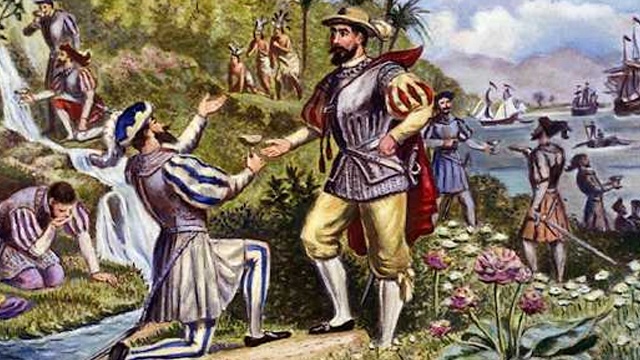 Juan Ponce de León was the first Spanish explorer to arrive in Florida. Early Spanish explorers were known as conquistadors (kahn-KEYS-ta-dawrz) or "conquerors." While there are no official records, historians believe that Ponce de León was born in 1460 in San Tervas de Campos, Spain. Source: http://fcit.usf.edu/florida/lessons/de_leon/de_leon1.htm
Juan Ponce de León was the first Spanish explorer to arrive in Florida. Early Spanish explorers were known as conquistadors (kahn-KEYS-ta-dawrz) or "conquerors." While there are no official records, historians believe that Ponce de León was born in 1460 in San Tervas de Campos, Spain. Source: http://fcit.usf.edu/florida/lessons/de_leon/de_leon1.htm
In 1493, Ponce de León sailed with Christopher Columbus on Columbus' second voyage to the Americas. He and his family settled on an island in the Caribbean named Hispaniola (Dominican Republic). He became a military commander at this post and was appointed deputy governor.
In 1506, Ponce de León discovered a nearby island named Borinquen. While there, he found large deposits of gold. Soon after his discovery, he left the island. He returned in 1508 on orders from the king of Spain to explore and colonize the island. He renamed the island Puerto Rico. He was the island's governor for two years until the king replaced him with Columbus' son.
Rumors of undiscovered islands to the northwest of Hispaniola had reached Spain by 1511, and Ferdinand was interested in forestalling further exploration and discovery by Colón. In an effort to reward Ponce de León for his services, Ferdinand urged him to seek these new lands outside the authority of Colón.[29] Ponce de León readily agreed to a new venture, and in February 1512 a royal contract was dispatched outlining his rights and authorities to search for "the Islands of Benimy".[30]
The contract stipulated that Ponce de León held exclusive rights to the discovery of Benimy and neighboring islands for the next three years. He would be governor for life of any lands he discovered, but he was expected to finance for himself all costs of exploration and settlement. In addition, the contract gave specific instructions for the distribution of gold, Native Americans, and other profits extracted from the new lands. Notably, there was no mention of a rejuvenating fountain.[31][32]
Ponce de León equipped three ships with at least 200 men at his own expense and set out from Puerto Rico on March 4, 1513.[33] The only near contemporary description known for this expedition comes from Antonio de Herrera y Tordesillas, a Spanish historian who apparently had access to the original ships' logs or related secondary sources from which he created a summary of the voyage published in 1601.[34][35] The brevity of the account and occasional gaps in the record have led historians to speculate and dispute many details of the voyage.
 The three ships in this small fleet were the Santiago, the San Cristobal and the Santa Maria de la Consolacion.[33] Anton de Alaminos was their chief pilot. He was already an experienced sailor, and would become one of the most respected pilots in the region. After leaving Puerto Rico, they sailed northwest along the great chain of Bahama Islands, known then as the Lucayos. On March 27, Easter Sunday, they sighted an island that was unfamiliar to the sailors on the expedition. Because many Spanish seamen were acquainted with the Bahamas, which had been depopulated by slaving ventures, some scholars believe that this "island" was actually Florida, as it was thought to be an island for several years after its formal discovery.[36] Other scholars have speculated that this island was one of the northern Bahama islands, perhaps Great Abaco.[37]
The three ships in this small fleet were the Santiago, the San Cristobal and the Santa Maria de la Consolacion.[33] Anton de Alaminos was their chief pilot. He was already an experienced sailor, and would become one of the most respected pilots in the region. After leaving Puerto Rico, they sailed northwest along the great chain of Bahama Islands, known then as the Lucayos. On March 27, Easter Sunday, they sighted an island that was unfamiliar to the sailors on the expedition. Because many Spanish seamen were acquainted with the Bahamas, which had been depopulated by slaving ventures, some scholars believe that this "island" was actually Florida, as it was thought to be an island for several years after its formal discovery.[36] Other scholars have speculated that this island was one of the northern Bahama islands, perhaps Great Abaco.[37]
For the next several days the fleet crossed open water until April 2, 1513,[33] when they sighted land which Ponce de León believed was another island. He named it La Florida in recognition of the verdant landscape and because it was the Easter season, which the Spaniards called Pascua Florida (Festival of Flowers).[33] The following day they came ashore to seek information and take possession of this new land.[38] The precise location of their landing on the Florida coast has been disputed for many years. Some historians believe it occurred at St. Augustine;[39] others prefer a more southern landing at a small harbor now called Ponce de León Inlet;[38] but many now agree that Ponce came ashore even farther south near the present location of Melbourne Beach.[40][41][42] The latitude coordinate recorded in the ship's log closest to the landing site, reported by Herrera, was 30 degrees, 8 minutes, most likely exaggerated to enforce land claims to justify the removal of French Protestants nearly 50 years later. This sighting was recorded at noon the day before with either a quadrant or a mariner's astrolabe, and the expedition sailed north for the remainder of the day before anchoring for the night and rowing ashore the following morning. This latitude suggests that the landing took place somewhere in the vicinity of Ponte Vedra Beach, north of St. Augustine. However replication of this journey now proves it impossible to sail against the current to such a northern latitude.
Source: https://en.wikipedia.org/wiki/Juan_Ponce_de_Le%C3%B3n
Spanish minister Do Luis de Onis and U.S. Secretary of State John Quincy Adams sign the Florida Purchase Treaty, in which Spain agrees to cede the remainder of its old province of Florida to the United States. more >>
Catholicism
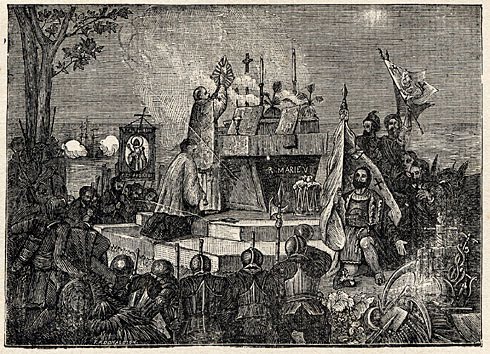 Seventy-three years later the Florida city of Saint Augustine was founded and established by Don Pedro Menéndez de Avilés. Upon coming ashore on September 8, 1565 Menéndez was presented a cross to kiss by Father López de Mendoza Grajales as the hymn Te Deum Laudamus was sung. The celebration of a Mass followed immediately.This Mass was celebrated to establish a city that became the oldest permanently occupied European settlement in what is now the United States of America. The first Cathedral and parish church and the entire city were destroyed in 1586 by the English pirate Sir Francis Drake under the direction of the British crown. The citizens rebuilt their city and church, but it was obvious that they needed greater securityand they construct a large stone fort of coquina rock.Today a 204-foot high Great Cross stands in the city today with with this legend.
"Place called Nombre de Dios (Name of God), which is the same where the first Mass was said on September 8, 1565…and afterwards an Indian mission was built there, with a chapel in which was placed an image of María Santisima de la Leche." More >>
Seventy-three years later the Florida city of Saint Augustine was founded and established by Don Pedro Menéndez de Avilés. Upon coming ashore on September 8, 1565 Menéndez was presented a cross to kiss by Father López de Mendoza Grajales as the hymn Te Deum Laudamus was sung. The celebration of a Mass followed immediately.This Mass was celebrated to establish a city that became the oldest permanently occupied European settlement in what is now the United States of America. The first Cathedral and parish church and the entire city were destroyed in 1586 by the English pirate Sir Francis Drake under the direction of the British crown. The citizens rebuilt their city and church, but it was obvious that they needed greater securityand they construct a large stone fort of coquina rock.Today a 204-foot high Great Cross stands in the city today with with this legend.
"Place called Nombre de Dios (Name of God), which is the same where the first Mass was said on September 8, 1565…and afterwards an Indian mission was built there, with a chapel in which was placed an image of María Santisima de la Leche." More >>
A Timeline of St. Augustine 1512–1886
more >>
In 1562, the French sent Jean Ribaut to Florida. He marked a spot on the St. Johns River for future settlement and then headed north to establish Charlesfort, which failed, in present-day Parris Island, South Carolina. Two years later, Rene Goulaine de Laudonniere established a French Huguenot settlement and Fort de la Caroline along the St. Johns River. Fort Caroline National Memorial, a unit of the Timucuan Ecological and Historic Preserve
In 1565, Spaniard Pedro Menendez de Aviles captured Fort Caroline in a brutal fight with the French and established St. Augustine, the first permanent European colony in North America. In 1567, Frenchman Dominique de Gourgues recaptured Fort Caroline. In 1569, the Spanish built a watchtower at Matanzas Inlet to watch the horizon and warn St. Augustine of approaching ships, a strategy that failed them in 1586, when Englishman Sir Francis Drake attacked and looted St. Augustine. The French effort to establish a colony in Florida is memorialized today at Fort Caroline National Memorial.
From the late 1500s through the 1700s, the Spanish sent annual convoys of merchant and military escort vessels from Cuba to Spain. Referred to as the Spanish plate fleets, the ships carried gold, silver and gemstones from the mines of Mexico and Peru, and porcelains, silks, pearls, spices and other highly sought goods from Asia that reached the Americas via the Spanish Manila Galleon fleet that crossed the Pacific.
The homeward bound Spanish plate fleets followed the Gulf Stream through the Straits of Florida and up the coast of North America before heading east for the Azores and Spain. The Spanish built Castillo de San Marcos and other coastal forts and settlements in Florida to provide protection from French and British raiders and pirates, and assist in saving survivors and salvaging cargoes from vessels that wrecked along Florida's shores as a result of hurricanes and mishaps.
Over the years, many Spanish ships were lost off the Florida coast with the greatest disasters suffered by the fleets of 1622, 1715 and 1733. During the 20th century, the remains of a number of lost ships have been found including the Nuestra Senora de Atocha from the 1622 fleet, the Urca de Lima from the 1715 fleet and the San Pedro from the 1733 fleet.
Source: http://www.nps.gov/nr/travel/flshipwrecks/maritimehistory.htm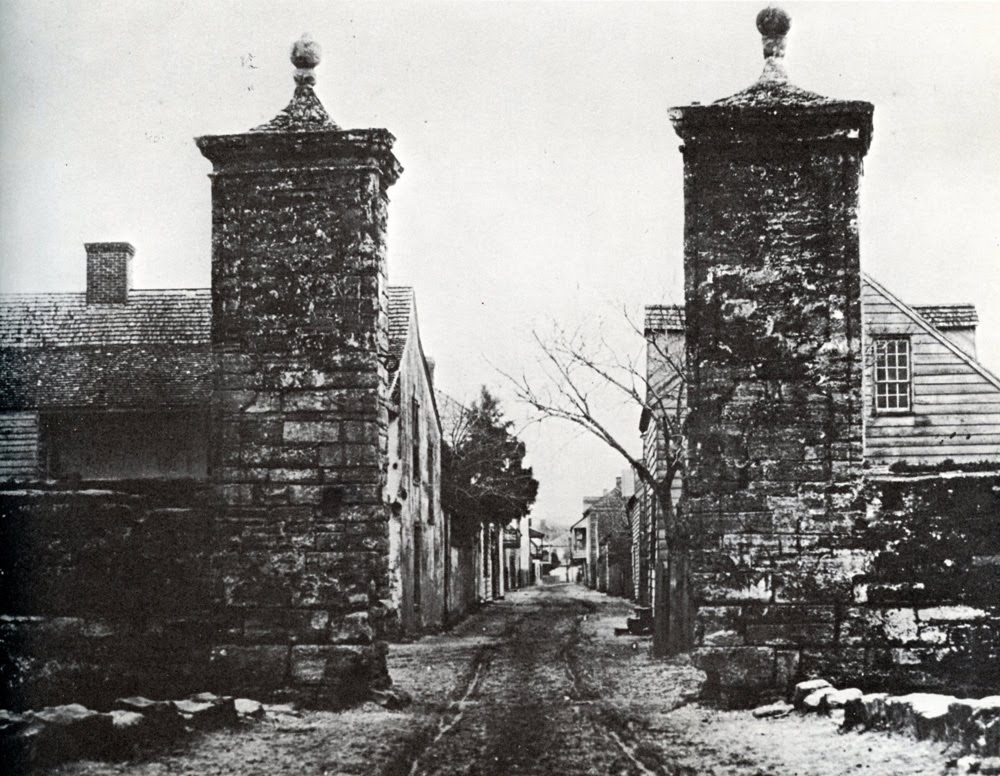 The colonies of East Florida and West Florida remained loyal to the British during the war for American independence, but by the Treaty of Paris in 1783 they returned to Spanish control. After 1783, Americans immigrants moved into West Florida.
The colonies of East Florida and West Florida remained loyal to the British during the war for American independence, but by the Treaty of Paris in 1783 they returned to Spanish control. After 1783, Americans immigrants moved into West Florida.
Attack by Carolina (See Defenses of St. Augustine)
In Europe the War of Spanish Succession would break out. In America it is known as Queen Anne's War with Spain and France against Britain.
September 7 the Carolina legislature votes to attack St. Augustine. On November 10,1702 St. Augustine was attacked by Carolina under Governor Moore. 600 soldiers and militia plus about 300 Indians made up the Carolina force commanded by Colonel Robert Daniel. The gates to the Castillo were closed. Captain James Daniel came down the St. Johns River and marched overland. Governor Moor arrived by sea. The Spanish Governor Joseph de Zuniga y Zeda ordered supplies to be placed in the Castillo and brought into the moat about 160 head of cattle. Inside the Castillo were 1500 men, women, and children. There were 230 soldiers and 100 Indian militia included in this number. The Spanish conceded the town to the British. Moore managed to burn the city down but the people successfully hid in the Castillo. On December 29 General Estevan de Berroa, the commander of the relief force, arrived from Havana and landed on Anastasia island.
The burning of the city left only the Castillo, the parish church (Nuestra Senora de la Soledad) and 20 structures of no value. Martin de Alacano reported that Nombre de Dios was also burnt down. Don't look for anything older than 1702 in St. Augustine other than the Castillo. (Pictures of older houses).
Source: http://www.drbronsontours.com/bronsonhistorypagefirstspanish1700.html
Spanish minister Do Luis de Onis and U.S. Secretary of State John Quincy Adams sign the Florida Purchase Treaty, in which Spain agrees to cede the remainder of its old province of Florida to the United States.
Spanish colonization of the Florida peninsula began at St. Augustine in 1565. The Spanish colonists enjoyed a brief period of relative stability before Florida came under attack from resentful Native Americans and ambitious English colonists to the north in the 17th century. Spain's last-minute entry into the French and Indian War on the side of France cost it Florida, which the British acquired through the first Treaty of Paris in 1763. After 20 years of British rule, however, Florida was returned to Spain as part of the second Treaty of Paris, which ended the American Revolution in 1783.
Spain's hold on Florida was tenuous in the years after American independence, and numerous boundary disputes developed with the United States. In 1819, after years of negotiations, Secretary of State John Quincy Adams achieved a diplomatic coup with the signing of the Florida Purchase Treaty, which officially put Florida into U.S. hands at no cost beyond the U.S. assumption of some $5 million of claims by U.S. citizens against Spain. Formal U.S. occupation began in 1821, and General Andrew Jackson, the hero of the War of 1812, was appointed military governor. Florida was organized as a U.S. territory in 1822 and was admitted into the Union as a slave state in 1845. Source: http://www.history.com/this-day-in-history/the-u-s-acquires-spanish-florida/print 1801–1829: Securing the Republic
In the early part of the 1800s, the United States developed more confidence as an independent nation. Acquisition of Florida: Treaty of Adams-Onis (1819) and Transcontinental Treaty (1821)
Opportunities to expand westward strengthened the notion that the United States should continue its quest to occupy more territory of the vast North American continent. The European powers did little to stop the young nation from extending its borders as they were embroiled in the ongoing Napoleonic Wars in Europe. More >>
Right: map of the Us in the 1800's.Source: https://history.state.gov/milestones/1801-1829/florida.
 World War
World War
When fighting broke out in Europe in 1914, news stories about the horrendous casualties on the Western Front seemed unrelated to life in the Oldest City. With European resorts closed by the fighting, St. Augustine soon received enough royalty and millionaires to revive all of the attractions that had proved so popular twenty years earlier. By mid-1917, the economic benefits of the war paled in comparison to the loss of America lives. Young men from St. Augustine were drafted or volunteered and the local National Guard units were mobilized. After their arrival in France, letters home described the terrible fighting and the people of St. Augustine became vitally interested in the war that had once seemed so far away. Many residents responded by buying Liberty Bonds, contributing to Red Cross programs and coping with food shortages. When the armistice final arrived, the St. Augustine Record reported that the city "went wild with patriotic enthusiasm".
A Decade of Progress In 1914, despite the distractions of "the War to End All Wars," St. Augustine embarked on an improvement program that would be long-referred to as the "decade of progress". A huge fire that year destroyed much of the area just north of the plaza, and the city began rebuilding after replacing horse-drawn fire pumps with the very latest motorized fire engines. In 1915, local leaders approved funding for the paving of 64 miles of roadways throughout St. Johns County. Inspired by the success of their road and the rapidly growing number of automobiles on the roads, St. Augustine's managers embarked on their first promotional program designed to attract automobile-owning families to the city and its beaches for a summer-long vacation. A paving program for city streets was conducted and gas street lamps illuminated the city's districts. St. Augustine's fishing fleet continued to grow, and a new city ice plant allowed the catch to be transported. Water and sewer systems were upgraded, electricity came into widespread use and the telephone system was expanded to include hotel rooms throughout St. Augustine.
Boom and Bust In 1925, developers D. P. Davis turned his attention to St. Augustine and revealed his ambitious plans for using the same dredging techniques he had mastered in Tampa to develop the marshy swamp at the end of Anastasia Island – an area clearly visible from downtown St. Augustine. Although Davis Shores was a major failure in the 1920s, it was revived thirty years later and now exists as one of the city's most popular residential areas. Davis' project was also largely responsible for the beautiful Bridge of Lions, completed in 1927 to provide easy access between the downtown area and the upscale homes that were expected to be built at Davis Shores.
During the Depression, St. Augustine's residents simply decided to work together until better days arrived. Fishing remained both a viable industry and a way to supplement the family's diet during hard times. Flagler's Florida East Coast Railroad continued to provide steady employment. With coordination and support from local churches, various organizations devoted to helping out during difficult times were quickly organized. The main Visitor Information Center at the intersection of Avenida Menendez and Castillo Drive was constructed as a civic center as part of the Works Progress Administration – a massive public works program designed to create jobs and make improvements to American communities. The same program also provided for significant improvements to the Government House.
Source: http://augustine.com/history/Old St. Augustine
Copyright © 2006-2015. oldstaugustine.com . All Rights Reserved. Power by Intraneting.com ![]()
